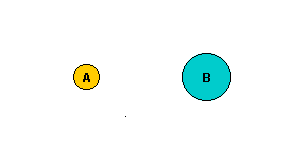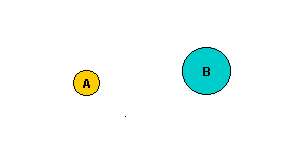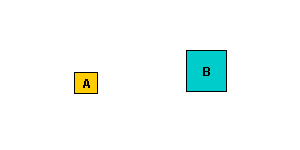By: Richard - redeyes2003 |
I am working on the
solution to a problem: A rigid body receives an impulse of a force, such
as in a collision. The case involves any free rigid body which can be
bombarded by a particle, causing a change in momentum of the rigid body.
However, the force, causing the momentum change, does not necessarily
act through the centre of mass in the rigid object, so rotation is at
play. I need to know what position/orientation the rigid body will have
any time after the impact. The mass and inertia of the rigid body is known,
and so too is the position, direction and magnitude of impulse. |
By: Richard - redeyes2003 |
Oh never mind, I think
I may have found the answer at |
By: Richard - redeyes2003 |
Hi Martin, I have
not gotten the idea of what to do about the problem I was inquiring. I
have looked at |
By: Martin Baker - martinbaker |
Hi Richard, |
By: Richard - redeyes2003 |
Hi Martin, |
By: Richard - redeyes2003 |
..........................Wooden block on table |
By: Richard - redeyes2003 |
Hi Martin, |
By: Martin Baker - martinbaker |
Hi Richard, |
By: Andy Goldstein
- andygoldstein |
All this discussion
brings back fond memories of superballs - the real ones that came out
in the late 60s, not the poor imitations available now. The original superball
was characterized by a coefficient of restitution of nearly 1 and a very
high surface friction. Aside from being a blast to play with, it was an
excellent demonstrator of how angular and linear momentum of an individual
body can be interchanged. Throw a superball with a significant backspin
or overspin, and the successive bounces will cover alternately long and
short strides, and the spin is reversed with each bounce and is traded
for linear momentum. |
By: Richard - redeyes2003 |
Thanks for your ideas,
Martin and Andy. I am learning new things everyday. |
By: Martin Baker - martinbaker |
I have found this
thread very useful because it started from the idea that the impulse is
known so what is the change in motion. In my past unsuccessful attempts
to get a general solution for 3D collisions the impulse is one of the
unknowns, I wonder if anyone has any thoughts on working back to calculating
the impulse? |
By: Richard - redeyes2003 |
Firstly, I would not say that calculating the impulse before
hand is the best way to carry out a simulation of colliding bodies, however
it is the method that I understand thus prefer. Up til now, I never attempted
to find its solution. |
By: Richard - redeyes2003 |
|
By: Richard - redeyes2003 |
There was a typo in
the last few lines, sorry. |
By: Richard - redeyes2003 |
Ok I did a small sim
so that I could see what happens in a perfectly elastic 1-d collision.
The sim had no obvious mention of conservation of momentum or final kinetic
energy. It was based on the small change is state of two bodies. Yet,
when it was running, it demonstated the conservation of energy and momentum
and gave the correct final velocities. |
By: Martin Baker - martinbaker |
Richard, Yes, I like the idea of using numerical methods: https://www.euclideanspace.com/physics/numerical/index.htm If we divide the complete object (not just the surface) into cubes and if the cubes are small enough then perhaps we can ignore the angular momentum of an individual cube about its own centre and just calculate the total angular momentum, about some fixed point, from the linear movement of each cube? But I would still like to try to work out a general analytical solution
for rigid body collision. In reading through your earlier approach I thought
it might be possible to get to a general solution by starting from a known
solution and then adding complexity: Movement, CM and impulse all in same line: impulse = 2(
CM and impulse in same line but movement offset. Since the CM of the two objects and the impulse are in line, it seems to me that the angular momentum of the two objects wont alter? It also seems that the impulse in the x-direction is only half the above value as it only has to stop the approach velocity and the impulse in the y-direction is also half the above value as has to start the diverge velocity at this same value? Therefore when the impulse is at 45 degrees: impulse in x dimension = ( impulse in y dimension = ( so I wonder if we can generalise this for any angle of the impulse?
|
By: Nobody/Anonymous - nobody |
I'm trying to figure out how linear to rotational, and rotational to
linear works. Obviously this is all about angles, and distance from the
centre of mass / point of rotation. But it's not listed on the site. |
By: Martin Baker - martinbaker |
Cata, |
By: Nobody/Anonymous - nobody |
Hmmmm... ok. I understand that. |
By: Martin Baker - martinbaker |
Cata, |
By: Richard - redeyes2003 |
Hello all, Martin, I started reasoning on this problem and so I tped
out the following as a start: |
By: Nobody/Anonymous - nobody |
Well, if you look at a simple, long thin object of 10x1 units with a
centre of mass in the middle (5,0.5), then a collision at any point off
the centre of mass will produce a rotational and linear movement. I.e.
(7.5,0). |
By: Richard - redeyes2003 |
Hi Carta, |
By: Richard - redeyes2003 |
OK, I am working this out 1 dimension at a time but ultimately in 3d. |
By: Richard - redeyes2003 |
con't |
By: Richard - redeyes2003 |
con't |
By: Richard - redeyes2003 |
Started thinking about the problem again and found a little breal tru.
Think I might actually have the solution by next year. |
By: Martin Baker - martinbaker |
Some thoughts: |
By: Richard - redeyes2003 |
OK I followed u up to dT = [I] da |
By: Martin Baker - martinbaker |
Don't forget that [I] is inertia tensor matrix so we cant divide by matrix
(although we can multiply by inverse of matrix) and we cant treat it like
a constant in the equations. |
By: Richard - redeyes2003 |
The (Ix, Iy, and Iz) that were used, were positive scalars. They are
the interias about each axis of the frame that is under consideration.
For simplicity, I used the frame when the [I] is diagonalized, ie the
frame in which Ix is the same as the tensor |
By: Richard - redeyes2003 |
I am attempting a minor detour, I think |
By: Richard - redeyes2003 |
Ahaaa progress... |
By: Richard - redeyes2003 |
I = Mrr = M.1/2D.1/2D |
By: Richard - redeyes2003 |
By using this method of equating the rotational inertia with that of
a point mass at a distance D/2, then |
By: Richard - redeyes2003 |
Simplified |




